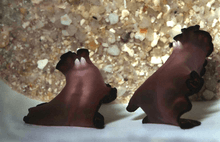Penis fencing

Penis fencing is a mating behavior engaged in by certain species of flatworm, such as Pseudobiceros hancockanus. Species which engage in the practice are hermaphroditic; each individual has both egg-producing ovaries and sperm-producing testes.[1]
The flatworms "fence" using two-headed dagger-like penises which are pointed, and white in color. The mating ritual involves a violent battle during which two hermaphroditic flatworms attempt to pierce the skin of one another with one of their penises. One organism will inseminate the other; this flatworm becomes the father. The sperm is absorbed through pores in the skin, causing fertilization in the second, who becomes the mother.[2][3][4] The battle may last up to an hour.[5]
Child-bearing, while necessary for successful offspring production, requires a considerable parental investment in time and energy, and according to Bateman's principle, almost always burdens the "mother". Thus, from a biological point of view, it is preferable to be the father rather than the mother. However, there are other hermaphroditic species where both partners try to be inseminated rather than to inseminate.[3]
Other uses
The term also applies to homosexual activity between two males in bonobos and in several whale species.[6][7]
See also
References
- ↑ Leslie Newman. "Fighting to mate: flatworm penis fencing". PBS.
- ↑ Michiels, N.K., and L.J. Newman. (1998). Sex and violence in hermaphrodites. Nature 391:647.
- ↑ 3.0 3.1 Hermaphrodites duel for manhood , Science News Online. Accessed 14 March 2009.
- ↑ Sonne, L., Coyote, P., Newman, L. (2001). The shape of life (rm) (Television production). PBS. Retrieved 15 February 2010.
- ↑ "World's Weirdest: Flatworm Penis Fencing". National Geographic. Retrieved 14 June 2014.
- ↑ Bonobo Sex and Society, by: de Waal, Frans B.M., Scientific American, 00368733, Mar95, Vol. 272, Issue 3 (Word document) "They also practice so-called penis-fencing, in which two males hang face to face from a branch while rubbing their erect penises together."
- ↑ Bruce Bagemihl, Biological Exuberance: Animal Homosexuality and Natural Diversity, St. Martin's Press, 1999; ISBN 978-0312253776